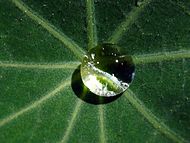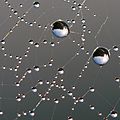Dew facts for kids
Dew is a thin layer of water that forms on surfaces near the ground. You often see it in the morning or evening. It happens when objects cool down at night. As they cool, the air right around them also gets colder.
This cooling makes tiny bits of water vapor in the air turn into liquid water. This process is called condensation. It's like when a cold drink gets water droplets on the outside of the glass. The temperature at which this condensation starts is called the dew point. If the dew point drops below freezing (0 °C or 32 °F), the dew turns into frost.
Most scientists agree that the water in dew comes from the air around us. However, some studies suggest that water can also come up from the soil and then condense on the ground. This only happens when the conditions are just right.
Dew forms best when the air is clean and still, with not much wind. You might also see a similar effect when your glasses get steamy in a warm, humid room. In factories, this process is usually called condensation instead of dew.
Contents
How Does Dew Form?
Water vapor in the air turns into tiny water droplets when the temperature drops. The specific temperature where these droplets begin to form is known as the dew point. When a surface cools down enough to reach this dew point, water vapor from the air condenses onto it. This creates the small drops of dew you see.
Dew is different from fog or clouds. Fog and clouds form when water vapor condenses directly in the air itself. Dew, however, forms on surfaces. The basic science behind how they all form is similar. Dew usually forms during the night.
Where Does Dew Happen?
Surfaces cool down enough for dew to form when they lose more heat than they gain. This often happens on clear nights. On these nights, the ground and objects radiate heat away into space. They don't get much heat back from the sun.
Objects that don't conduct heat well or are well-insulated from the warmer ground are best for dew. For example, plants or leaves often collect a lot of dew. Shiny metal surfaces don't usually get much dew because they don't radiate heat away as well.
The best weather for dew includes clear skies and enough moisture in the air near the ground. Clear skies mean less "greenhouse effect" from clouds, allowing more heat to escape. Calm nights are usually good because strong winds can bring warmer air from higher up to the cold surface.
However, if the air is the main source of moisture (called dewfall), a little bit of wind can actually help. It helps bring new moist air to the surface. But if the moisture comes mostly from wet soil (called distillation), wind usually stops dew from forming.
Why is Dew Important?
Dew can provide a small amount of water, especially in dry places. It can add up to about 0.5 mm of water per night. While this isn't as much as rain, it can be very helpful for plants in areas with long dry seasons. For example, plants like lichen or young pine trees can benefit from dew.
In very dry places like the Atacama Desert or the Namib desert, most of the natural water for plants comes from fog, not dew. But in the Negev Desert in Israel, dew provides almost half the water for some desert plants.
Dew also helps fungi grow. It keeps the surfaces where fungi live moist. For instance, it helps fungi like Pleated Inkcaps on lawns. It also helps Phytophthora infestans, which causes a disease called blight in potato plants.
Dew in History
People have known about dew for a very long time. An ancient Greek book called De Mundo, written over 2,000 years ago, described dew as "moisture minute in composition falling from a clear sky."
In ancient Greek stories, Ersa was known as the goddess of dew.
Dew, called tal in Hebrew, is important in the Jewish religion. It's significant for both farming and religious reasons. On the first day of Passover, there's a special prayer for dew to fall until the holiday of Sukkot. During the rainy season, prayers also ask for blessed dew along with rain. Many Jewish writings also talk about dew as a symbol of new life or even resurrection.
The Bible also mentions dew. In Deuteronomy 32:2, it says: "My doctrine shall drop as the rain, my speech shall distill as the dew, as the small rain upon the tender herb, and as the showers upon the grass." This shows how dew was seen as gentle and life-giving.
Can We Collect Dew?
For a long time, people have tried to collect dew. Some old structures, like large stone piles in Ukraine or medieval "dew ponds" in England, were once thought to collect dew. However, it was later found that they worked using other methods, not mainly by collecting dew.
Today, there's an organization called the International Organisation for Dew Utilization. They are working on new ways to collect dew using special foil-based surfaces. These could help provide water in places where there isn't enough rain or fog all year round.
Large systems for collecting dew have been built in Kutch, a dry coastal area in India. These systems can collect over 200 liters of dew water per night. This happens for about 90 nights during the dew season (October to May). Research shows that dew can be a helpful extra source of water in dry coastal areas.
One idea for collecting dew on a very large scale involves circulating cold sea water through special collectors near the coast. These collectors would then condense dew and fog to provide clean drinking water.
Gallery
-
Dew that has formed on a spider web
Images for kids
-
Dew formed on the surface of strawberry leaves
See also
 In Spanish: Rocío (fenómeno físico) para niños
In Spanish: Rocío (fenómeno físico) para niños













